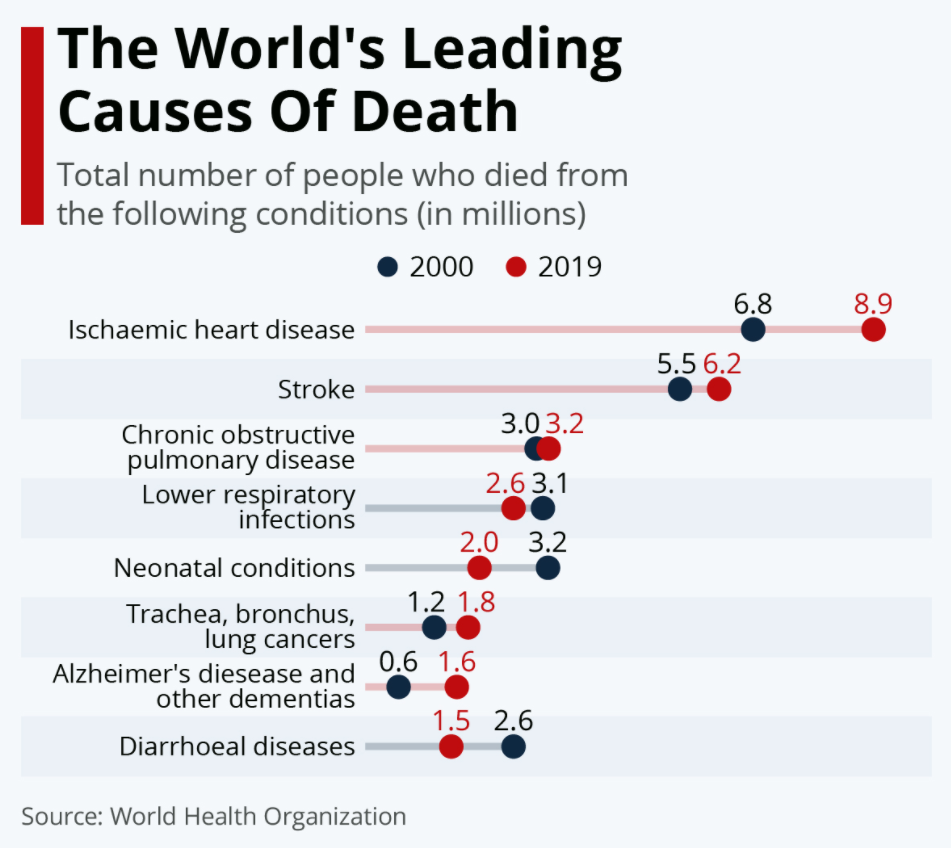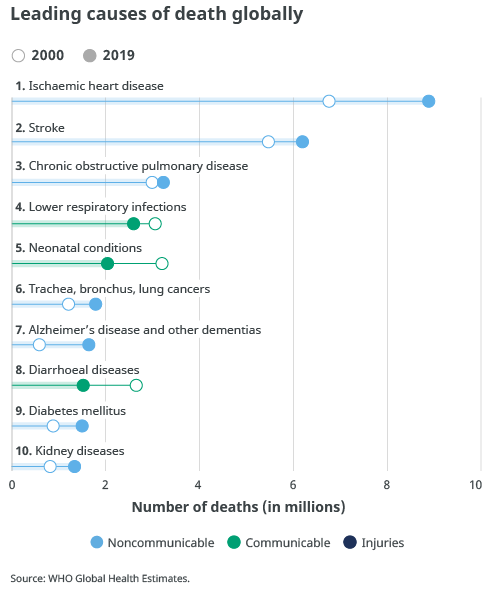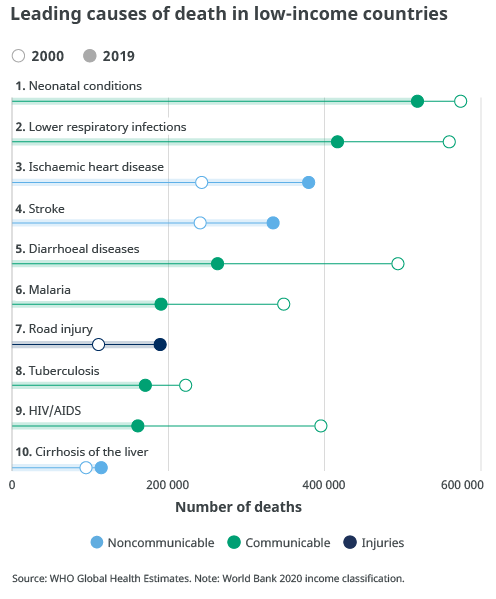WHO
9 December 2020
Executive Summary:
Joaquim Cardoso MSc.
Health Transformation Journal
September 7, 2022 (ifpma)
What are the leading causes of death?
- In 2019, the top 10 causes of death accounted for 55% of the 55.4 million deaths worldwide.
- Noncommunicable diseases now make up 7 of the world’s top 10 causes of death, according to WHO’s 2019 Global Health Estimates,
- This is an increase from 4 of the 10 leading causes in 2000. The new data cover the period from 2000 to 2019 inclusive.
Infographic:

- The top global causes of death, in order of total number of lives lost, are associated with three broad topics:
(1) cardiovascular (ischaemic heart disease, stroke),
(2) respiratory (chronic obstructive pulmonary disease, lower respiratory infections) and
(3) neonatal conditions — which include birth asphyxia and birth trauma, neonatal sepsis and infections, and preterm birth complications.
Leading causes of death globally
- At a global level, 7 of the 10 leading causes of deaths in 2019 were noncommunicable diseases.
- These seven causes accounted for 44% of all deaths or 80% of the top 10.
- However, all noncommunicable diseases together accounted for 74% of deaths globally in 2019.
i.Heart diseases:
The world’s biggest killer is ischaemic heart disease, responsible for 16% of the world’s total deaths.
- Since 2000, the largest increase in deaths has been for this disease,
rising by more than 2 million
- to 8.9 million deaths in 2019.
ii.Respiratory diseases:
Stroke and chronic obstructive pulmonary disease are the 2nd and 3rd leading causes of death, responsible for approximately 11% and 6% of total deaths respectively.
- Lower respiratory infections remained the world’s most deadly communicable disease, ranked as the 4th leading cause of death.
- However, the number of deaths has gone down substantially: in 2019 it claimed 2.6 million lives, 460 000 fewer than in 2000.
iii.Neonatal conditions
Neonatal conditions are ranked 5th. However, deaths from neonatal conditions are one of the categories for which the global decrease in deaths in absolute numbers over the past two decades has been the greatest:
- these conditions killed 2 million newborns and young children in 2019,
- 1.2 million fewer than in 2000.
Deaths from noncommunicable diseases are on the rise.
iv.Cancer:
Trachea, bronchus and lung cancers deaths have risen
- from 1.2 million
- to 1.8 million and are now ranked 6th among leading causes of death.
v.Alzheimer
In 2019, Alzheimer’s disease and other forms of dementia ranked as the 7th leading cause of death.
- Women are disproportionately affected.
- Globally, 65% of deaths from Alzheimer’s and other forms of dementia are women.

What are the recommendations?
- They clearly highlight the need for an intensified global focus on preventing and treating cardiovascular diseases, cancer, diabetes and chronic respiratory diseases, as well as tackling injuries, in all regions of the world, as set out in the agenda for the UN Sustainable Development Goals.
- “These new estimates are another reminder that we need to rapidly step up prevention, diagnosis and treatment of noncommunicable diseases,” said Dr Tedros Adhanom Ghebreyesus, Director-General of WHO.
- “They highlight the urgency of drastically improving primary health care equitably and holistically.
- Strong primary health care is clearly the foundation on which everything rests, from combatting noncommunicable diseases to managing a global pandemic.”
ORIGINAL PUBLICATION (full version) — 2 parts

Noncommunicable diseases now make up 7 of the world’s top 10 causes of death, according to WHO’s 2019 Global Health Estimates, published today.
This is an increase from 4 of the 10 leading causes in 2000. The new data cover the period from 2000 to 2019 inclusive.
The estimates reveal trends over the last 2 decades in mortality and morbidity caused by diseases and injuries.
They clearly highlight the need for an intensified global focus on preventing and treating cardiovascular diseases, cancer, diabetes and chronic respiratory diseases, as well as tackling injuries, in all regions of the world, as set out in the agenda for the UN Sustainable Development Goals.
…there is a need for an intensified global focus on preventing and treating cardiovascular diseases, cancer, diabetes and chronic respiratory diseases, as well as tackling injuries,
“These new estimates are another reminder that we need to rapidly step up prevention, diagnosis and treatment of noncommunicable diseases,” said Dr Tedros Adhanom Ghebreyesus, Director-General of WHO.
“They highlight the urgency of drastically improving primary health care equitably and holistically.
Strong primary health care is clearly the foundation on which everything rests, from combatting noncommunicable diseases to managing a global pandemic.”
“They highlight the urgency of drastically improving primary health care equitably and holistically.
Strong primary health care is clearly the foundation on which everything rests, from combatting noncommunicable diseases to managing a global pandemic.”

Heart disease remains the number 1 killer; diabetes and dementia enter the top 10
Heart disease has remained the leading cause of death at the global level for the last 20 years.
However, it is now killing more people than ever before.
The number of deaths from heart disease increased by
- more than 2 million since 2000,
- to nearly 9 million in 2019.
Heart disease now represents 16% of total deaths from all causes.
- More than half of the 2 million additional deaths were in the WHO Western Pacific region.
- Conversely, the European region has seen a relative decline in heart disease, with deaths falling by 15% [1].
Alzheimer’s disease and other forms of dementia are now among the top 10 causes of death worldwide, ranking 3rd in both the Americas and Europe in 2019.
Women are disproportionally affected: globally, 65% of deaths from Alzheimer’s and other forms of dementia are women.
Deaths from diabetes increased by 70% globally between 2000 and 2019, with an 80% rise in deaths among males.
In the Eastern Mediterranean, deaths from diabetes have more than doubled and represent the greatest percentage increase of all WHO regions.

Global decline in deaths from communicable diseases, but still a major challenge in low- and middle-income countries
In 2019, pneumonia and other lower respiratory infections were the deadliest group of communicable diseases and together ranked as the fourth leading cause of death.
However, compared to 2000, lower respiratory infections were claiming fewer lives than in the past, with the global number of deaths decreasing by nearly half a million.
This reduction is in line with a general global decline in the percentage of deaths caused by communicable diseases.
For example, HIV/AIDS dropped from the 8th leading cause of death in 2000 to the 19th in 2019, reflecting the success of efforts to prevent infection, test for the virus and treat the disease over the last two decades.
While it remains the fourth leading cause of death in Africa, the number of deaths has dropped by more than half,
- falling from over 1 million in 2000
- to 435 000 in 2019 in Africa.
Tuberculosis is also no longer in the global top 10, falling from 7th place in 2000 to thirteenth in 2019, with a 30% reduction in global deaths.
- Yet, it remains among the top 10 causes of deaths in the African and South-East Asian regions, where it is the 8th and 5th leading cause respectively.
- Africa saw an increase in tuberculosis mortality after 2000, though this has started to decline in the last few years.
The new estimates also emphasize the toll that communicable diseases still take in low-income countries:
- 6 of the top 10 causes of death in low-income countries are still communicable diseases, including malaria (6th), tuberculosis (8th) and HIV/AIDS (9th).
- Meanwhile, in recent years, WHO reports highlight an overall concerning slow-down or plateauing of progress against infectious diseases like HIV, tuberculosis and malaria.

People are living longer — but with more disability
The estimates further confirm the growing trend for longevity:
- in 2019, people were living more than 6 years longer than in 2000, with a global average of more than 73 years in 2019
- compared to nearly 67 in 2000.
But on average, only 5 of those additional years were lived in good health.
Indeed, disability is on the rise.
To a large extent, the diseases and health conditions that are causing the most deaths are those that are responsible for the greatest number of healthy life-years lost.
Heart disease, diabetes, stroke, lung cancer and chronic obstructive pulmonary disease were collectively responsible for nearly 100 million additional healthy life-years lost in 2019 compared to 2000.
Injuries are another major cause of disability and death:
there has been a significant rise in road traffic injuries in the African region since 2000, with an almost 50% increase in both death and healthy life-years lost.
Similar but slightly smaller increases (at around 40%) were also observed for the Eastern Mediterranean region.
Globally, deaths from road traffic injuries are 75% male.
In the Americas, drug use has emerged as a significant contributor to both disability and death.
There was a nearly threefold increase in deaths from drug use disorders in the Americas between 2000 and 2019.
This region is also the only one for which drug use disorder is a top 10 contributor to healthy life-years lost due to premature deaths and disability, while in all other regions, drug use does not make the top 25.

Data sources and methodology
WHO’s Global Health Estimates present comprehensive, comparable and transparent time-series data for population health, including life expectancy, healthy life expectancy, mortality and morbidity, and burden of disease at global, regional and country levels disaggregated by age, sex and cause, from 2000 onwards.
“These estimates are produced using data from the best available sources from countries and the international community,” said Dr Bochen Cao, the technical lead for WHO’s Global Health Estimates. “They are based on robust scientific methods for the processing, synthesis and analysis of data.
These updated estimates also benefited from the valuable contributions of WHO’s Member States through active country consultation and dialogue.”
The availability of services to prevent, diagnose and treat disease is key to reducing death and disability, influencing where different conditions are ranked.
These new estimates clearly indicate where additional investments in services are most urgently needed.
The availability of services to prevent, diagnose and treat disease is key to reducing death and disability, influencing where different conditions are ranked.
These new estimates clearly indicate where additional investments in services are most urgently needed.
“Robust health data are critical to address inequalities, prioritize policies and allocate resources to prevent disability and save lives,” adds Dr Samira Asma, Assistant Director-General for the Division of Data, Analytics and Delivery for Impact at WHO.
“The WHO Global Health Estimates are a powerful tool to maximize health and economic impact. We call upon governments and stakeholders to urgently invest in data and health information systems to support timely and effective decision-making.”
“Robust health data are critical to address inequalities, prioritize policies and allocate resources to prevent disability and save lives,”… We call upon governments and stakeholders to urgently invest in data and health information systems to support timely and effective decision-making.”
As of today, COVID-19 has tragically claimed more than 1.5 million lives. People living with pre-existing health conditions (such as heart disease, diabetes and respiratory conditions) are at higher risk of complications and death due to COVID-19.
Health authorities worldwide depend on timely, reliable and actionable data to make informed decisions — this is especially true during a global pandemic.
The next update to these estimates will include an assessment of the direct and indirect impact of the COVID-19 pandemic on mortality and morbidity.
Originally published at https://www.who.int on December 7, 2020.
ORIGINAL PUBLICATION — Part 2


The top 10 causes of death
WHO, 9 December 2020
In 2019, the top 10 causes of death accounted for 55% of the 55.4 million deaths worldwide.
The top global causes of death, in order of total number of lives lost, are associated with three broad topics: cardiovascular (ischaemic heart disease, stroke), respiratory (chronic obstructive pulmonary disease, lower respiratory infections) and neonatal conditions — which include birth asphyxia and birth trauma, neonatal sepsis and infections, and preterm birth complications.
Causes of death can be grouped into three categories:
- communicable (infectious and parasitic diseases and maternal, perinatal and nutritional conditions),
- noncommunicable (chronic) and
- injuries.
Leading causes of death globally
At a global level, 7 of the 10 leading causes of deaths in 2019 were noncommunicable diseases.
These seven causes accounted for 44% of all deaths or 80% of the top 10.
However, all noncommunicable diseases together accounted for 74% of deaths globally in 2019.

The world’s biggest killer is ischaemic heart disease, responsible for 16% of the world’s total deaths.
- Since 2000, the largest increase in deaths has been for this disease,
rising by more than 2 million - to 8.9 million deaths in 2019.
Stroke and chronic obstructive pulmonary disease are the 2nd and 3rd leading causes of death, responsible for approximately 11% and 6% of total deaths respectively.
Lower respiratory infections remained the world’s most deadly communicable disease, ranked as the 4th leading cause of death.
However, the number of deaths has gone down substantially: in 2019 it claimed 2.6 million lives, 460 000 fewer than in 2000.
Neonatal conditions are ranked 5th.
However, deaths from neonatal conditions are one of the categories for which the global decrease in deaths in absolute numbers over the past two decades has been the greatest:
- these conditions killed 2 million newborns and young children in 2019,
- 1.2 million fewer than in 2000.
Deaths from noncommunicable diseases are on the rise.
Trachea, bronchus and lung cancers deaths have risen
- from 1.2 million
- to 1.8 million and are now ranked 6th among leading causes of death.
In 2019, Alzheimer’s disease and other forms of dementia ranked as the 7th leading cause of death.
Women are disproportionately affected.
Globally, 65% of deaths from Alzheimer’s and other forms of dementia are women.
One of the largest declines in the number of deaths is from diarrhoeal diseases, with global deaths falling
- from 2.6 million in 2000
- to 1.5 million in 2019.
Diabetes has entered the top 10 causes of death, following a significant percentage increase of 70% since 2000.
Diabetes is also responsible for the largest rise in male deaths among the top 10, with an 80% increase since 2000.
Other diseases which were among the top 10 causes of death in 2000 are no longer on the list.
HIV/AIDS is one of them.
Deaths from HIV/AIDS have fallen by 51% during the last 20 years, moving from the world’s 8th leading cause of death in 2000 to the 19th in 2019.
Kidney diseases have risen from the world’s 13th leading cause of death to the 10th. Mortality has increased from 813 000 in 2000 to 1.3 million in 2019.

Leading causes of death by income group
The World Bank classifies the world’s economies into four income groups — based on gross national income — low, lower-middle, upper-middle and high.

People living in a low-income country are far more likely to die of a communicable disease than a noncommunicable disease.
Despite the global decline, six of the top 10 causes of death in low-income countries are communicable diseases.
Malaria, tuberculosis and HIV/AIDS all remain in the top 10. However, all three are falling significantly. The biggest decrease among the top 10 deaths in this group has been for HIV/AIDS, with 59% fewer deaths in 2019 than in 2000, or 161 000 and 395 000 respectively.
Diarrhoeal diseases are more significant as a cause of death in low-income countries: they rank in the top 5 causes of death for this income category. Nonetheless, diarrhoeal diseases are decreasing in low-income countries, representing the second biggest decrease in fatalities among the top 10 (231 000 fewer deaths).
Deaths due to chronic obstructive pulmonary disease are particularly infrequent in low-income countries compared to other income groups. It does not appear in the top 10 for low-income countries yet ranks in the top 5 for all other income groups.

Lower-middle-income countries have the most disparate top 10 causes of death: five noncommunicable, four communicable, and one injury. Diabetes is a rising cause of death in this income group: it has moved from the 15th to 9th leading cause of death and the number of deaths from this disease has nearly doubled since 2000.
As a top 10 cause of death in this income group, diarrhoeal diseases remain a significant challenge. However, this category of diseases represents the biggest decrease in absolute deaths, falling from 1.9 million to 1.1 million between 2000 and 2019. The biggest increase in absolute deaths is from ischaemic heart disease, rising by more than 1 million to 3.1 million since 2000. HIV/AIDS has seen the biggest decrease in rank among the previous top 10 causes of death in 2000, moving from 8th to 15th.

In upper-middle-income countries, there has been a notable rise in deaths from lung cancer, which have increased by 411 000; more than double the increase in deaths of all three other income groups combined. In addition, stomach cancer features highly in upper-middle-income countries compared to the other income groups, remaining the only group with this disease in the top 10 causes of death.
One of the biggest decreases in terms of absolute number of deaths is for chronic obstructive pulmonary disease, which has fallen by nearly 264 000 to 1.3 million deaths. However, deaths from ischaemic heart disease have increased by more than 1.2 million, the largest rise in any income group in terms of absolute number of deaths from this cause.
There is only one communicable disease (lower respiratory infections) in the top 10 causes of death for upper-middle-income countries. Notably, there has been a 31% fall in deaths from suicide since 2000 in this income category, decreasing to 234 000 deaths in 2019.

In high-income countries, deaths are increasing for all top 10 diseases except two. Ischaemic heart disease and stroke are the only causes of death in the top 10 for which the total numbers have gone down between 2000 and 2019, by 16% (or 327 000 deaths) and by 21% (or 205 000 deaths) respectively. High-income is the only category of income group in which there have been decreasing numbers of deaths from these two diseases. Nonetheless ischaemic heart disease and stroke have remained in the top three causes of death for this income category, with a combined total of over 2.5 million fatalities in 2019. In addition, deaths from hypertensive heart disease are rising. Reflecting a global trend, this disease has risen from the 18th leading cause of death to the 9th.
Deaths due to Alzheimer’s disease and other dementias have increased, overtaking stroke to become the second leading cause in high-income countries, and being responsible for the deaths of 814 000 people in 2019. And, as with upper-middle-income countries, only one communicable disease, lower respiratory infections, appears in the top 10 causes of death.
Why do we need to know the reasons people die?
It is important to know why people die to improve how people live. Measuring how many people die each year helps to assess the effectiveness of our health systems and direct resources to where they are needed most. For example, mortality data can help focus activities and resource allocation among sectors such as transportation, food and agriculture, and the environment as well as health.
COVID-19 has highlighted the importance for countries to invest in civil registration and vital statistics systems to allow daily counting of deaths, and direct prevention and treatment efforts. It has also revealed inherent fragmentation in data collection systems in most low-income countries, where policy-makers still do not know with confidence how many people die and of what causes.
To address this critical gap, WHO has partnered with global actors to launch Revealing the Toll of COVID-19: Technical Package for Rapid Mortality Surveillance and Epidemic Response. By providing the tools and guidance for rapid mortality surveillance, countries can collect data on total number of deaths by day, week, sex, age and location, thus enabling health leaders to trigger more timely efforts for improvements to health.
Furthermore, the World Health Organization develops standards and best practices for data collection, processing and synthesis through the consolidated and improved International Classification of Diseases (ICD-11) — a digital platform that facilitates reporting of timely and accurate data for causes of death for countries to routinely generate and use health information that conforms to international standards.
The routine collection and analysis of high-quality data on deaths and causes of death, as well as data on disability, disaggregated by age, sex and geographic location, is essential for improving health and reducing deaths and disability across the world.
Editor’s note
WHO’s Global Health Estimates, from which the information in this fact sheet is extracted, present comprehensive and comparable health-related data, including life expectancy, healthy life expectancy, mortality and morbidity, and burden of diseases at global, regional and country levels disaggregated by age, sex and cause. The estimates released in 2020 report on trends for more than 160 diseases and injuries annually from 2000 to 2019.
Originally published at https://www.who.int/ (Part 2)
Names mentioned:
Dr Tedros Adhanom Ghebreyesus, Director-General of WHO
Dr Bochen Cao, the technical lead for WHO’s Global Health Estimates.
Dr Samira Asma, Assistant Director-General for the Division of Data, Analytics and Delivery for Impact at WHO.












